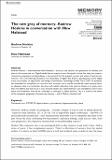Files in this item
The new grey of memory
Item metadata
| dc.contributor.author | Hoskins, Andrew | |
| dc.contributor.author | Halstead, Huw Yiannis | |
| dc.date.accessioned | 2021-07-15T09:30:03Z | |
| dc.date.available | 2021-07-15T09:30:03Z | |
| dc.date.issued | 2021-06-08 | |
| dc.identifier | 273685139 | |
| dc.identifier | b0100e3f-1e99-40b0-bc73-5c6599cbbc38 | |
| dc.identifier | 000659176600010 | |
| dc.identifier | 85107568843 | |
| dc.identifier.citation | Hoskins , A & Halstead , H Y 2021 , ' The new grey of memory ' , Memory Studies , vol. 14 , no. 3 , pp. 675-685 . https://doi.org/10.1177/17506980211010936 | en |
| dc.identifier.issn | 1750-6980 | |
| dc.identifier.other | ORCID: /0000-0002-8788-4325/work/96141558 | |
| dc.identifier.uri | https://hdl.handle.net/10023/23571 | |
| dc.description.abstract | Andrew Hoskins – interviewed by Huw Halstead – discusses the tensions and paradoxes of memory and place in the connective era. Digital media liberate memory from the spatial archive, but they also create a connective compulsion and dependency, a disconnect from the present moment and a loss of control over memory. The overwhelming abundance and immediacy of digital data breed a placelessness of the digital traces of ourselves, an algorithmic narrowing of information, knowledge and life. The COVID-19 pandemic has intensified this compulsion to record to such an extent that it may be considered a new memory boom, an obsessive desire to remember. Locative and mobile technology may seem to locate us in space more than ever before, but they do so in ways that are beyond our comprehension: our smartphones know more about our locatedness than we do, ushering in a ‘new grey’ in digital memory. Yet, it is critical to be aware of the variegated geography of connective memory – and of Memory Studies itself. | |
| dc.format.extent | 92600 | |
| dc.language.iso | eng | |
| dc.relation.ispartof | Memory Studies | en |
| dc.subject | Connective turn | en |
| dc.subject | COVID-19 | en |
| dc.subject | Digital memory | en |
| dc.subject | Grey memory | en |
| dc.subject | Hyperconnectivity | en |
| dc.subject | Place | en |
| dc.subject | D History (General) | en |
| dc.subject | T-NDAS | en |
| dc.subject.lcc | D1 | en |
| dc.title | The new grey of memory | en |
| dc.type | Journal article | en |
| dc.contributor.institution | University of St Andrews. School of History | en |
| dc.identifier.doi | 10.1177/17506980211010936 | |
| dc.description.status | Peer reviewed | en |
This item appears in the following Collection(s)
Items in the St Andrews Research Repository are protected by copyright, with all rights reserved, unless otherwise indicated.

